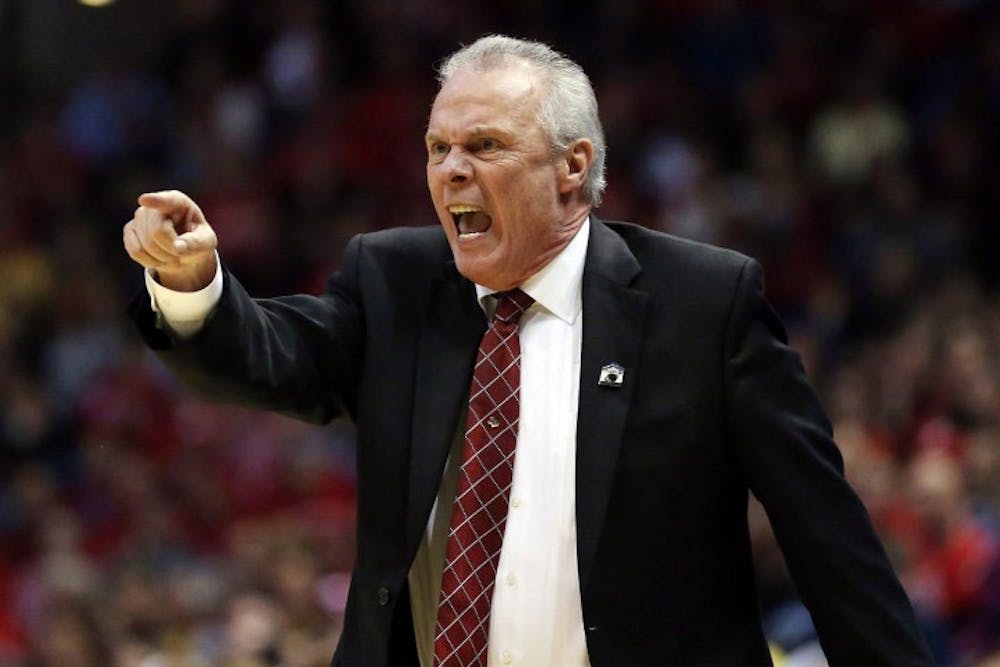In a post-game interview Monday night that was nearly lost in all the hullabaloo surrounding Duke and Coach K’s fifth national championship win, Wisconsin Coach Bo Ryan took an interesting jab at the Blue Devils’ program, saying, “We don’t do rent-a-player.”
The comment — made in reference to Duke freshmen Jahlil Okafor and Justise Winslow, both of whom are expected to declare for the upcoming NBA draft — came right after some harsh words about the officiating in the game and can be easily understood as Ryan simply making excuses. But it addresses a qualm about NCAA hoops that many fans have had for almost a decade now.
In 2005, the NBA and the player’s union reached a new collective bargaining agreement that required anyone entering the NBA draft to be at least 19 years old and at least one year removed from high school. After the change, players like LeBron James, Kobe Bryant and Kevin Garnett, who all opted not to play in college and went directly to the NBA, were succeeded by players like Kevin Durant, Derrick Rose and Anthony Davis, who each played one year at Texas, Memphis and Kentucky, respectively, before leaving to the NBA.
Fans are split about the one-and-done rule — and I assume the majority of opinions are as much based on what their favorite teams are doing rather than actual ideology. If you’re a big fan of Kentucky, Duke or Kansas — which seems like half the country — then one-and-done is probably great. If you’re a fan of a team that has to play Kentucky, Duke or Kansas, you probably hate the rule.
But the arguments against one-and-done are often misdirected, with pundits, fans and coaches (see Ryan, Bo) blaming the NCAA and individual programs for letting it happen. There’s this idea that these programs are breaking some unspoken rule, sacrificing team-building and developed systems — the fundamentals of the traditional college basketball landscape that older fans are nostalgic for — for fleeting success.
These attacks are misguided. The claims of the phenomenon being bad for college basketball may hold water, but don’t blame a program for wanting to do whatever it takes to win a national championship. If a coach thinks that bringing on freakishly athletic but raw talent improves his chances of winning, he can and should make that choice. As much as fans and donors may like to see a “classy” program that reflects second-half 20th Century college basketball, they’ll always enjoy winning championships more.
If, however, college basketball stakeholders think the system as a whole is toxic and bad for the game, then one-and-done needs to be addressed systematically — not by chastising individual programs or banning freshman competition at the conference level. And since the NCAA can’t force players to stay in college, the change needs to come from the NBA.
One of two things could happen to fix the problem: the CBA could either raise or lower the age limit. Raising it would keep stars in college for longer and likely elevate the level of play in college basketball but would also require the best players to forego potentially millions of dollars in income, which would be even more unfair to these players than the current system.
The prefered option would be to eliminate the age limit and let the one-and-dones go straight to the NBA. An even better option would be to simultaneously expand the NBA’s D-League and add rounds to the draft. This way, the best players get paid right away, the college teams lose the pressure of having to take players that will only stay for a year and the risks aren’t as high for the NBA teams who opt to draft players right out of college.
The thing is, the NBA has very little incentive to make this happen. The franchises are just fine not having to take risks on high school players and subsequently develop them, so long as they have a fair shot of drafting them when they become eligible. Current players are fine not having young stars on their rosters, who often times unjustly take up salary cap space and whose immaturity could be detrimental to the success of a team.
However, there certainly is value in a larger draft or an expanded farm system. Major League Baseball and European soccer leagues seemed to have learned that. Teams are always looking to gain a competitive edge, so if they’re willing to take some risk on young and undeveloped talent, they should have the means to do so without taking up precious cap and roster space. Teams may be able to make some money through ticket sales for games, but the greatest value comes with the prospects of picking a superstar before anyone else notices him.
This system also alleviates some of the issues surrounding paying college athletes. One of the biggest problems with the way things currently work is that the top players don’t have many options besides playing for free at a college. An expanded farm system would allow the best players to get paid without having to move to a foreign country, should they so choose.
The main point is that the one-and-done phenomenon in not a result of wayward and unorthodox head coaches, or even the much-maligned NCAA; rather, it is a product of the NBA’s stubbornness. Its practice of discriminating on the basis of age for little legitimate reason needs to stop for the good of the players, the NBA teams and college basketball. How exactly the NBA could be persuaded to do this, I don’t yet know.





